With thanks to the Linen Hall Library, Belfast, for providing the artefacts that appear on this page
The Troubles and the Titanic: according to Liam Kennedy, emeritus professor of economic history at Queen's University Belfast, the "two Ts" are what Northern Ireland is known for around the world.
And while international tourists can learn about the ill-fated liner at the highly successful Titanic Belfast visitor attraction, there is no specific place they can go to understand exactly what happened during the conflict, nor is there a dedicated venue for local people to reflect on it.
It is precisely this gap that Prof Kennedy, together with a group of other academics and business consultants, proposes to fill with an ambitious new institution: a national museum of the Troubles.
Kennedy and his group, the Museum of the Troubles Initiative (MOTI), envisage a “multi-faceted mega-project”: a world-class museum, interpretive centre and visitor attraction, which would draw on a vast array of sources such as film footage, interviews and testimonies, murals, posters, drama, poetry and music, as well as material culture such as weaponry, flags and uniforms.
Pointing out that Northern Ireland’s recent history is about much more than simply bloodshed, Kennedy wants to trace a long narrative arc stretching from the 1960s to the present day, taking in both the descent into violence of the 1970s and the achievements of the Belfast Agreement.
More controversially, Kennedy also suggests the use of digital technology to simulate immersive experiences such as ambush sites and even car-bomb explosions. At present the group is still developing the concept, exploring funding opportunities with philanthropic organisations, and seeking out a suitable site in Belfast, possibly right on the peace wall between the Lower Falls and the Shankill.
Living memory
“Now is the time to engage, while it is still within living memory,” insists Kennedy. “We need to face up to the past and deal with it, and while there are clearly great difficulties in doing that, a museum, which is, after all, an exercise in public history, might be one of the more effective ways. In facing up to what happened, we need to listen to all the different voices, and represent them – we could build a cathedral of narratives.”
Kennedy advocates an inclusive, comprehensive approach where all perspectives could be accommodated. So does he envisage this as the next best thing to a truth commission?
“It’s the closest we’ll ever get. Truth recovery hasn’t happened and it won’t happen. But through the medium of a museum we could make the materials for people to come to their own judgements.”
Kennedy thinks that far from being “a parochial bit of bother”, the conflict in Northern Ireland has a much wider global resonance.
“The Troubles was a world-class problem in miniature. The dynamics bear a close resemblance to disputes in deeply-divided societies elsewhere, revolving round issues of ethnicity, nationality, religion, class and language.”
But who would foot the bill for such a grand project?
“We think it shouldn’t be difficult to raise the tens of millions required if the idea is good and it serves an important social function.”
Opponents
One of the most impassioned opponents of the plan for a Troubles museum is Kennedy’s friend and colleague at Queen’s, the literary critic and cultural historian John Wilson Foster.
“What do we have to teach the world about harmony?” he asks.
Rather than using the euphemism of “the Troubles”, Foster calls that period “the years of our disgrace”, a “protracted episode of human wickedness”.
And he believes that we are nowhere near the point where such a vast, interactive permanent exhibition could be developed with the necessary “coolness, scrupulosity and balance” that museums require.
“Even if we were even to plan to commemorate the “Years of Disgrace” with a profitable tourist destination while victims of those years still nurse wounds, endure nightmares and suffer the pains of loss, would be unseemly.”
Foster is wary of placing artefacts from the conflict, such as guns, on display. “Objects by definition accrue dignity, and then that becomes a component of a larger dignifying that’s going on. Before you know it, you’re dignifying what ought to be abhorred.”
He is also concerned that the horror of that time would inevitably be sanitised by a public display. “The most powerful installation you could show would be the aftermath of a bomb, but you couldn’t do that because people would be vomiting when they saw it.”
Foster’s most fundamental difficulty with a Troubles museum is a moral one. He admits to a “visceral aversion to the idea of a mega-project that would, in my opinion, suck the oxygen out of our moral environment and install those deplorable and violent decades as worthy monuments to our past, to be offered for sale to visitors for their enjoyment and, unavoidably, warped admiration.”
Kennedy acknowledges the need for extreme sensitivity in dealing with past atrocities, as well as the need for dialogue with victims and survivors. But he and his colleagues are determined to push ahead with their plan, firm in the belief that it offers opportunities for new understanding and empathy.
New display
So what would such a museum look like? The only existing template is the Troubles display at the Ulster Museum, a show which has recently reopened after a major overhaul.
William Blair, director of collections at National Museums Northern Ireland, admits that the previous display, which was tentative, text-heavy and contained no artefacts, had been characterised by a “strategy of avoidance…the monochrome uniformity meant that there was no sense of being on a journey”.
The new display, The Troubles and Beyond, is more complex and adventurous in scope. Exhibits include a bomb disposal robot, plastic bullets and a menu signed by Ian Paisley and others from a dinner held at the Europa Hotel to mark the fall of the Sunningdale power-sharing executive.
A particularly poignant item is the guest book from the Ulster American Folk Park from August 15th, 1998, signed by 12-year-old Fernando Blasco Baselga, a Spanish schoolboy who was killed later that day in the Omagh bomb.
“There is a power in the objects,” says Blair. “It’s about how you frame them, to let opposing perspectives reveal themselves.”
Kathryn Thomson, the chief executive of National Museums Northern Ireland, says that the display is “a safe place to explore difficult questions, and we’re inviting the public to engage with that conversation”.
Sectarian death threats
One person who is extremely well-versed in the flotsam and jetsam of the Troubles is Dr Kris Brown of Ulster University. Some years ago he took on the enormous task of compiling a full inventory of artefacts relating to the conflict – from footballs inscribed with sectarian death threats that were kicked over the peace line, to an IRA mark 10 mortar – with a view to a possible future museum. What does he make of Foster’s critique of the proposed new institution?
“Well, he says that what happened [in the past] was shameful, and that’s quite true. But people are passing on the folk history of the conflict anyway, and a museum could provide a historically-informed counter-balance to that.”
Brown likes the idea of siting such a museum at a peace line.
“Obviously it’s historically resonant, but it’s also a liminal space, it doesn’t belong to anyone. The problem with somewhere like the Maze/Long Kesh site is that it’s so loaded. There’s a sacral, commemorative feel to it that would override more historical approaches to representing the Troubles.”
He points to Beit Beirut, a museum and cultural centre in the Lebanese capital which attempts to deal with the heavily-contested issues of a divided society. “It sits on the green line, smack dab in the battle zone. It’s pock-marked with rocket holes. But it does challenge accepted notions.”
While Foster is disturbed by the almost voyeuristic impulse which draws people towards items associated with violent conflict, Peter Moloney, a retired architect based in London, takes a very different approach. Moloney has spent most of his life amassing Troubles memorabilia, and he isn’t ashamed of this fascination, which he describes as “in the blood”.
Propaganda
Such was his zeal for gathering republican and loyalist propaganda – he always made sure that his collection was 50/50 balanced – that he would arouse the suspicions of the security forces and was frequently arrested. Moloney recently donated his collection of over 40,000 objects to the Tower Museum in Derry, having run out of space for it in his Camden home.
He hopes the objects will have an educative purpose, particularly for the young generations who have no memory of the conflict, and that they will act as a spur towards peace and reconciliation.
So would Moloney support a museum of the Troubles? “Yes, I would be fascinated to see it. I hope it comes to pass. The war is over now. I think it’s safe to show an interest.”
TROUBLES ARTEFACTS FROM THE LINEN HALL LIBRARY POLITICAL COLLECTION
All of these objects are from the archive of the Northern Ireland Political Collection (NIPC) held at the Linen Hall Library in Belfast. The collection began in 1969 when Jimmy Vitty, the librarian at the time, was handed a civil rights leaflet in a Belfast bar and decided to keep it. The library has now collected more than a quarter of a million items, comprehensively documenting the activities and views of all parties to the conflict from paramilitaries to governments.
1. Bigots Beer bottle and King William’s Orange Preserve
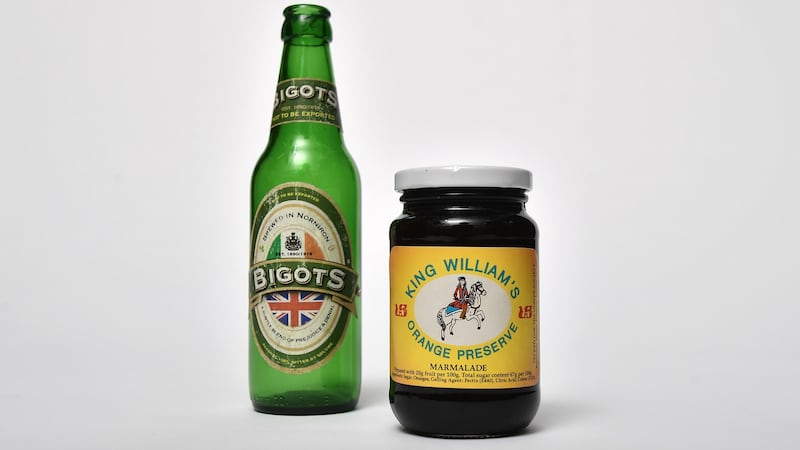
Part of an anti-sectarianism campaign by the NUS-USI student organisation, Bigots Beer was described as “a subtle blend of prejudice and denial” and marked “not to be exported”. Accompanying beer mats stated that “Bigots Beer is our special brew, drunk in local colleges for many years. NUS-USI and your Students’ Union need your support to actively challenge sectarianism and discrimination on campus. Join the campaign and pour Bigots Beer down the drain.” The mats also carried a “student health warning”: “Bigots Beer is a potent brew and side effects can last for years”.
The King William Orange Preserve was one of two specially-made jams produced for the Ulster Society based in Lurgan, Co Armagh. Nuala O'Faolain, writing in The Irish Times in 1998, mentions buying a pot of the marmalade in Derry: she pronounced it "excellent", but pointed out that "this marmalade comes, like almost everything in Northern Ireland, with tribal credentials". A jar of Ulster Society jam containing blackcurrant preserve was labelled The Blackman's Dream, a reference to another loyal order, the Royal Black Institution.
2. Defaced coins
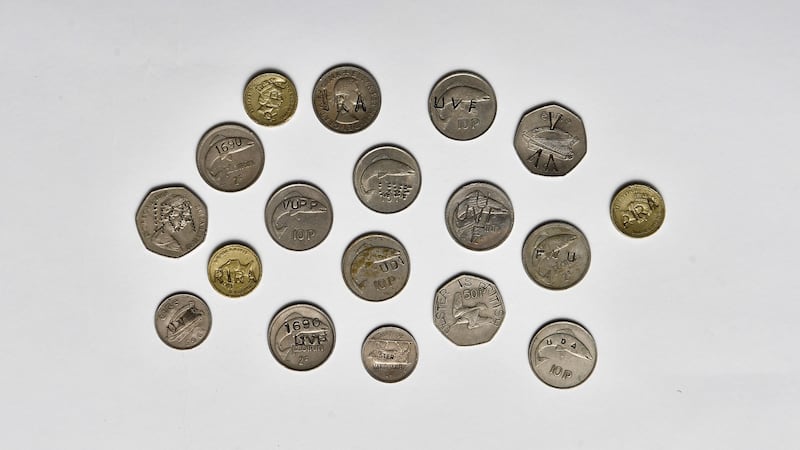
During the 1970s many British and Irish coins were defaced with paramilitary names or slogans, particularly in Border counties, where both currencies were in circulation. Letters were stamped, punched or carved on the coins. Here, a 1970 Irish 50p piece has been stamped with the words "Ulster is British", while an Irish 10p piece has been marked with the letters "UDA". Although the practice of defacing coins was at its height in the 1970s, it continued throughout the Troubles, as shown by a British one pound coin from 1993, which has been stamped with "RIRA" (Real IRA) across the Queen's head. In some cases the lettering has been achieved neatly and with precision, while in others the letters are crudely hacked into the surface of the coin. As the authors Catherine Flood and Gavin Grindon note in their book Disobedient Objects, defacing currency is a long-established act of political defiance. For example, a 1903 penny held by the British Museum has the words "Votes for Women" stamped over the face of King Edward VII. Flood and Grindon write: "A currency is a highly controlled symbol of a state, and tampering with it is a small but powerful act of subversion."
3. Keys from Springfield Road barracks
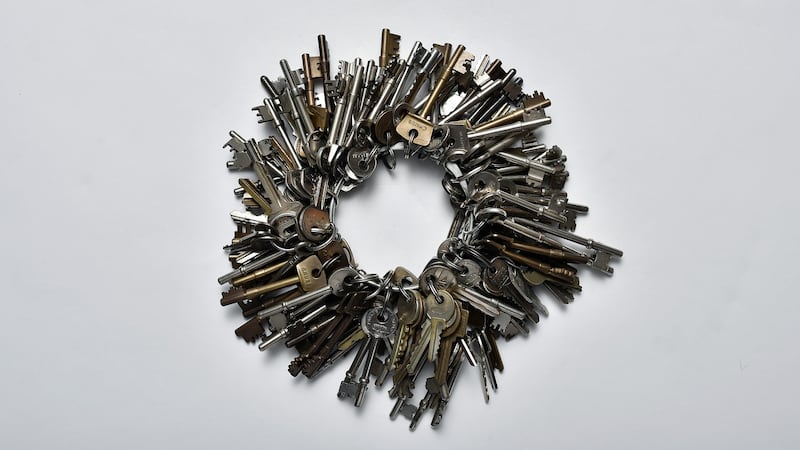
This gigantic (and very heavy) bunch of keys comes from Springfield Road RUC barracks in West Belfast, which stood close to the Falls Road. Large numbers of soldiers and police officers were based there, and it became a frequent target for terrorists. In 1971, a Parachute Regiment sergeant, Michael Willetts, was killed when he shielded two young children as a terrorist threw a bomb in a suitcase into the public inquiries office of the station. In the same year a labourer from south Armagh, Harry Thornton, was shot dead by a soldier as he drove past the barracks. The Ballymurphy massacre, in which 10 people were shot dead by the army, happened two days later. The gates of the highly-fortified station, made of reinforced steel, finally closed in 2002, and the building was subsequently demolished. The land was sold to a housing association in 2004. Welcoming the move at the time, Alex Atwood of the SDLP said: “New houses and new community facilities will stand as permanent testimony to what can be achieved by a positive, engaged approach to the new realities of policing.” The bunch of keys, to doors long destroyed, is all that remains of the notorious barracks.
4. Baby bibs
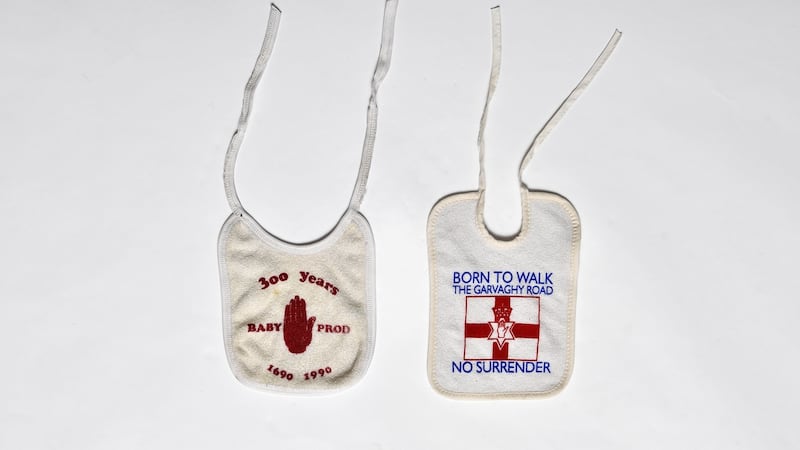
Baby bibs celebrating Protestant culture became particularly popular in loyalist circles following a long-running standoff at Drumcree church outside Portadown, Co Armagh. The dispute began in June 1995, when nationalist residents blocked an Orange Order parade route past the Garvaghy Road as Orangemen returned from a church service. Since 1998, the parade has been banned from the Garvaghy Road by the Northern Ireland Parades Commission. One towelling bib bears the legend “Born to Walk the Garvaghy Road – No Surrender” while the other, emblazoned “Baby Prod”, pre-dates the Drumcree crisis, instead celebrating the 300th anniversary of the Battle of the Boyne in 1990. An alternative version of the Garvaghy Road bib says “Born to Walk Derry’s Walls”, which refers to another contested marching route. More recently, personalised bibs, vests and T-shirts have begun appearing, sometimes featuring the name of the child, such as “Isabella’s First 12th July, Tandragee”. Last year a printing company in Portadown was criticised by anti-sectarian campaigners for selling children’s clothes with loyalist slogans.
5. A Republican ABC

This hand-made republican children's book, A Republican ABC, is a rarity, made during the 1970s, and never widely circulated. The author and illustrator is unknown. Each double page features a letter of the alphabet on the left hand page and a block-print illustration on the right, many celebrating violent republican tactics and victories. The black and white book begins "A is for Armalite that sends them all running", with an image of a short-skirted girl taking aim with a gun, her hair falling over her face. On another page "D is for Derry where the Bogside rose up", and the text is accompanied by an image of crudely-drawn figures with a flag and petrol bombs. Underneath is written: "Steady on your aim with the petrol bomb. Don't throw it, son, till the peelers come. I am the Bogside man." Other pages take inspiration from elsewhere: for example, "K is for Kremlin, whose cause brings no joy" shows the uniformed figure of Stalin – clearly labelled in case of doubt – and questions British Communist Party policy on Ireland during the 1970s.
6. Jail-craft, handbag and wallet
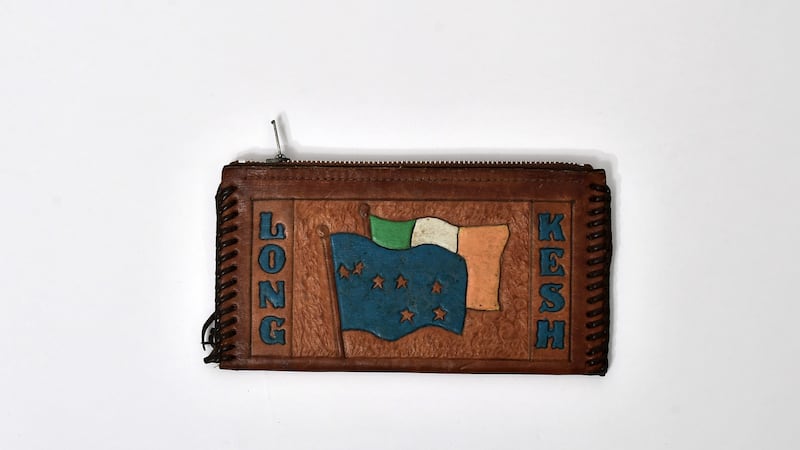
The substantial women’s handbag, its full provenance unknown, is one of many items of craft-work made by inmates at Long Kesh/Maze prison during the Troubles. The bag is made from brown tooled leather using Celtic designs, with the name “Eleanor” inscribed along the top. The zipped leather purse, also a piece of well-preserved jail-craft, shows two flags, the Irish Tricolour and the Starry Plough flag, and the words “Long Kesh”. While some items were intended to be auctioned for fundraising purposes, other pieces were made as gifts for family and friends, and the name on the handbag strongly suggests that it was made with a particular recipient in mind. The prisoners had to be inventive with their tools – a toothbrush handle with the blade of a pencil sharpener was often used for carving. Some were extremely ambitious projects, showing high levels of technical skill, such as harps and high crosses carved from solid mahogany and intricately decorated with Celtic knot-work. Each piece of a full tea-set made by female republican prisoners was inscribed with a motif of a lark breaking free from a ball and chain. Other pieces are more basic, such as handkerchiefs on which prisoners used felt-tip pens to depict snipers shooting soldiers, or to inscribe the “sniper’s prayer”.
7. Prison comms (communications)
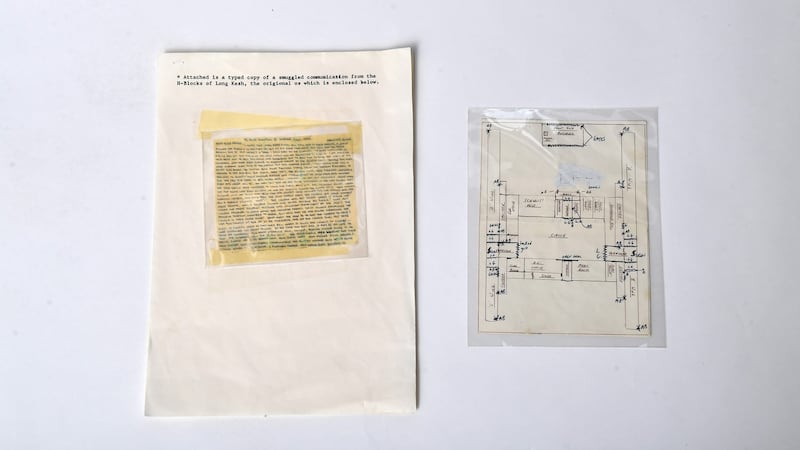
Prison comms, or communications, were letters in minuscule writing, often inscribed on toilet paper and hidden in intimate parts of the body before being smuggled out of the jail, sometimes via a kiss between prisoners and visitors. This “comm” shows a detailed escape map with key areas of the jail clearly labelled: screws’ mess, medic room, canteen. Open and locked grilles are marked with zigzag lines in pen. The other “comm” is a letter to Pope John Paul II from a prisoner called Sam Millar, held in H-Block 5, dated November 30th, 1980. In precise, microscopic capitals it reads: “Dear Holy Father, I hope this small note finds you well and in good health. Please excuse the paper it is written on … I am writing this note not to tell you about our conditions but to beg you to save the lives of my comrades who have been forced to hunger strike by the British government. By the time you get this it may be too late to save my comrades. You must speak out loudly now …The Irish people are waiting for your voice, please let it be heard now.” Millar later revealed that this was one of over 2,000 letters he wrote in the hope of gathering support for the hunger strikers.
8. Vinyl LP records, various
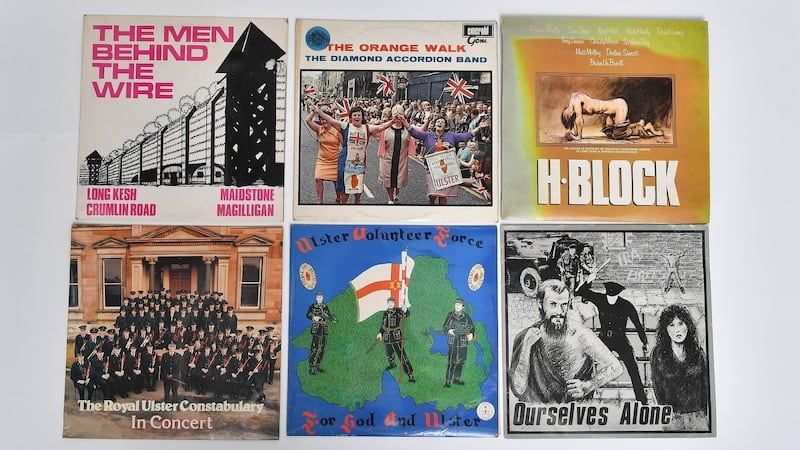
In Northern Ireland in the 1970s and 1980s, making records was not just for rock stars. Musicians – whether amateur or professional, famous or unknown – took to the recording studio to create vinyl LPs championing their preferred cause. H-Block, from 1978, was an album made by Irish folk artists, recorded "in support of political prisoners in Long Kesh and Armagh Women's Gaol" and produced by Christy Moore. It featured Stephen Rea reading two works by Bobby Sands, and songs included On the Blanket and Guest of the Queen. According to Moore, the launch of the album was raided by Special Branch forces. The Ulster Volunteer Force album For God and Ulster dates from 1975, and was released to "pay tribute to loyal Protestants who have sacrificed so much for our beloved Ulster". Produced by Loyalist Records, Belfast, it features three armed men in combat fatigues on the cover, and contains songs such as The Red Hand Soldier and Never Trust a Rebel. Even the police made their own records. The Royal Ulster Constabulary Band in Concert, the RUC's first outing in vinyl, carries a glowing recommendation from the then chief constable Sir Kenneth Newman. Side One includes songs like Jamaican Folk Melody and Soldiers' Chorus from Faust, while Side Two opens with Hawaiian Samba and ends with American Patrol.










